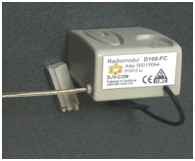Where the bees fly away, where the beekeepers look for their new nest – always spring care. But in the apiary, where hives with electronic sensors are installed, you will not have to catch the fugitives.
Usually a random buzz is heard from the hive. It consists of sounds of various frequencies – from 100 to 600 Hz. During the swarming period, the strength and buzzing tone change dramatically. The buzz becomes monotonous and concentrated – its frequency range is 200-280 Hz. One of the sensor channels is configured on them, that captures the profiles of active frequencies and transfers them to the server, which allows the beekeeper to analyze the beginning of the swarming of bees.
The profitability of beekeeping farms depends on the efficiency of bee colonies during the collection of honey. Uncontrolled swarming causes great economic damage. The developed sensor does not require constant disassembly of the hives and interference in the life of the bee colony.
The readings of instruments measuring the absolute value of noise intensity do not provide reliable information. The intensity ratio of the two narrow-band noise signals should be estimated. It is shown that the active state of the bee colony (spring development, honey collection) is characterized by the maximum intensity of the spectral components in the frequency band 260 … 320 Hz – channel 2.
With a decrease in activity (swarming, illness, absence of the uterus), the maximum of the spectrum shifts to 210 … 250 Hz – channel 1. Having determined which of these ranges the noise intensity is greater, one can judge the state of the bees.
The proposed acoustic diagnostic sensor, operating on this principle, is equipped with two recording channels: 210 … 250 Hz – channel 1 and 260 … 320 Hz – channel 2.
In the case of an inoperative state of the bee colony, associated, for example, with swarming, lack of brood space or overloading the nest with honey, an increased signal value is observed at 210 … 250 Hz – channel 1 compared to the signal level at 260 … 320 Hz – channel 2, which means that inactive hives accumulate in the hive and the bee family will enter the swarm stage in the coming days.
In the case of analyzing the relationship of the family to the planted bee, she received 210 … 250 Hz – channel 1 or rejected 260 … 320 Hz – channel 2.
The condition of wintering bees is satisfactory – calm, if 210 … 250 Hz – channel 1, or poor – excited 260 … 320 Hz – channel 2.
The third recording channel serves to confirm the shift of the frequency spectrum to the lower side – confirmation of channel 1 or the upper side – confirmation of channel 2.
The device is powered by three AA batteries. The current consumption does not exceed 2mA, and the new batteries last for two to three months.
It is possible to connect additional sensors for temperature, humidity and VOC content (volatile organic substances).
To check the condition of the bee colony, the microphone of the device is placed on a canvas covering the frames with bees. An insulation pad is placed on top to reduce external noise. Diagnosis in the ” queen bee” mode is carried out after a queen bee is placed in a hive in the “Titov’s cage”. After about half an hour, you can request data from the radio module to determine if it has been received by bees.
Thanks to the automated control system, it is possible to obtain sound information for each family equipped with beehive controllers, and the number of families can be unlimited. The system is applicable for year-round monitoring of bees by the sound spectrum and is convenient because it can be used to extract sound information from all apiary hives. no need to disturb the microclimate of the nest.
DJV-COM offers BALANCE hardware and software platform, and also seeks interested parties for cooperation.
The BALANCE mobile app can be downloaded here:
https://play.google.com/store/apps/details?id=com.djv.balance
More information on the website www.djv-com.org, and we will be glad to hear recommendations and suggestions from you at office@djv-com.net.





